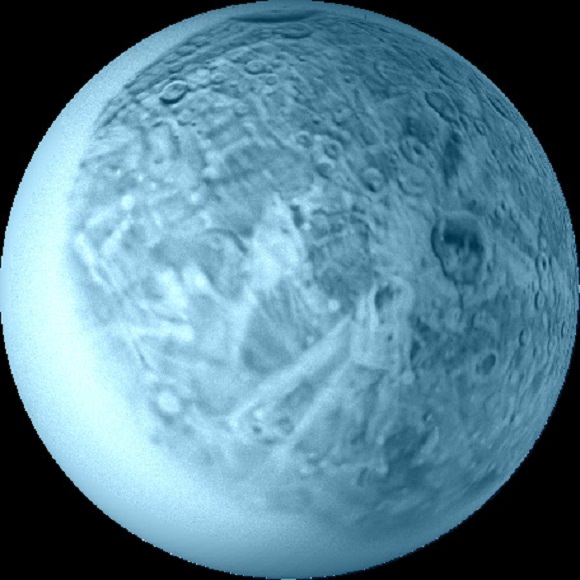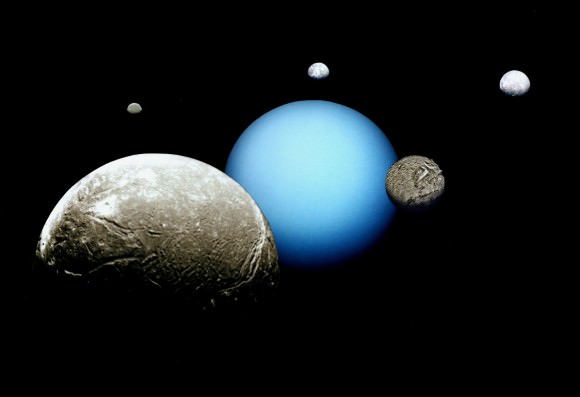In 1610, Galileo’s observed four satellites orbiting the distant gas giant of Jupiter. This discovery would ignite a revolution in astronomy, and encouraged further examinations of the outer Solar System to see what other mysteries it held. In the centuries that followed, astronomers not only discovered that other gas giants had similar systems of moons, but that these systems were rather extensive.
For example, Uranus has a system of 27 confirmed satellites. Of these, Oberon is the outermost satellite, as well as the second largest and second most-massive. Named in honor of a mythical king of fairies, it is also the ninth most massive moon in the Solar System.
Discovery and Naming:
Discovered in 1787 by Sir William Herschel, Oberon was one of two major satellites discovered in a single day (the other being Uranus’ moon of Titania). At the time, he reported observing four other moons; however, the Royal Astronomical Society would later determine that these were spurious. It would be almost five decades after the moons were discovered that an astronomer other than Herschel observed them.
Initially, Oberon was referred to as “the second satellite of Uranus”, and in 1848, was given the designation Uranus II by William Lassell. In 1851, Lassell discovered Uranus’ other two moons – later named Ariel and Miranda – and began numbering them based on their distance from the planet . Oberon was thus given the designation of Uranus IV.

By 1852, Herschel’s son John suggested naming the moon’s his father observed Oberon and Titania, at the request of Lassell himself. All of these names were taken from the works of William Shakespeare and Alexander Pope, with the name Oberon being derived from the King of the Fairies in A Midsummer Night’s Dream.
Size, Mass and Orbit:
With a diameter of approx. 1,523 kilometers, a surface area of 7,285,000 km², and a mass of 3.014 ± 0.075 x 10²¹ kilograms, Oberon is the second largest, and second most massive of Uranus’ moons. It is also the ninth most massive moon in the solar system.
At a distance of 584,000 km from Uranus, it is the farthest of the five major moons from Uranus. However, this distance is subject to change, as Oberon has a small orbital eccentricity and inclination relative to Uranus’ equator. It has an orbital period of about 13.5 days, coincident with its rotational period. This means that Oberon is a tidally-locked, synchronous satellite with one face always pointing toward the planet.
Since (like all of Uranus’ moons) Oberon orbits the planet around its equatorial plane, and Uranus orbits the Sun almost on its side, the moon experiences a rather extreme seasonal cycle. Essentially, both the northern and southern poles spend a period of 42 years in complete darkness or complete sunlight – with the sun rising close to the zenith over one of the poles at each solstice.
Voyager 2:
So far, the only close-up images of Oberon have been provided by the Voyager 2 probe, which photographed the moon during its flyby of Uranus in January 1986. The images cover about 40% of the surface, but only 25% of the surface was imaged with a resolution that allows geological mapping.
In addition, the time of the flyby coincided with the southern hemisphere’s summer solstice, when nearly the entire northern hemisphere was in darkness. This prevented the northern hemisphere from being studied in any detail. No other spacecraft has visited the Uranian system before or since, and no missions to the planet are currently being planned.
Composition:
Oberon’s density is higher than the typical density of Uranus’ satellites, at 1.63 g/cm³. This would indicate that the moon consists of roughly equal proportions of water ice and a dense non-ice component. The latter could be made of rock and carbonaceous material including heavy organic compounds.
Spectroscopic observations have confirmed the presence of crystalline water ice in the surface of the moon. It is believed that Oberon, much like the other Uranian moons, consists of an icy mantle surrounding a rocky core. If this is true, then the radius of the core (480 km) would be equal to approx. 63% of the radius of the moon, and its mass would be around 54% of the moon’s mass.

Currently, the full composition of the icy mantle is unknown. However, it it were to contain enough ammonia or other antifreeze compounds, the moon may possess a liquid ocean layer at the core–mantle boundary. The thickness of this ocean, if it exists, would be up to 40 km and its temperature would be around 180 K.
It is unlikely that at these temperatures, such an ocean could support life. But assuming that hydrothermal vents exist in the interior, it is possible life could exist in small patches near the core. However, the internal structure of Oberon depends heavily on its thermal history, which is poorly known at present.
Interesting Facts:
Oberon is the second-darkest large moon of Uranus (after Umbriel), with a surface that appears to be generally red in color – except where fresh impact deposits have left neutral or slightly blue colors. In fact, Oberon is the reddest moon amongst its peers, with a trailing hemisphere that is significantly redder than its leading hemisphere.
The reddening of the surfaces is often a result of space weathering caused by bombardment of the surface by charged particles and micrometeorites over many millions of years. However, the color asymmetry of Oberon is more likely caused by accretion of a reddish material spiraling in from outer parts of the Uranian system.
Oberon’s surface is the most heavily cratered of all the Uranian moons, which would indicate that Oberon has the most ancient surface among them. Consistent with the planet’s name, these surface features are named after characters in Shakespearean plays. The largest known crater, Hamlet, measures 206 kilometers in diameter, while the Macbeth, Romeo, and Othello craters measure 203, 159, and 114 km respectively.

Other prominent surface features are what is known as chasmata – steep-sided depressions that are comparable to rift valleys or escarpments here on Earth. The largest known chasmata on Oberon is the Mommur Chasma, which measures 537 km in diameter and takes its name from the enchanted forest in French folklore that was ruled by Oberon.
As you can plainly see, there is much that remains unknown about this satellite. Much like its peers, how they came to be, and what secrets may lurk beneath their surfaces, is still open to speculation. One can only hope that future generations will choose to mount another Voyager-like expedition to the Outer Solar System for the sake of studying the Uranian satellites.
We have written many interesting articles on the moons of Uranus here at Universe Today. Here’s How Many Moons Does Uranus Have? and Interesting Facts About Uranus.
For more information, check out NASA’s Solar System Exploration page on Oberon and Nine Planet’s page on Oberon.
Astronomy Cast also has a good episode on the subject. Here’s Episode 62: Uranus.
Sources:


One Theory states that at least the gas giant Jupiter orbited considerably closer to the sun in the early solar system. This was probably enough heat to start life on Jupiter’s moons if they cooled down enough from formation. So when Jupiter took it’s family of moons out into the outer solar system, those moons had life. But now after being frozen for the majority of their lives, I highly doubt any life still exists. But to find even the traces that life indeed existed, fills me with hope for our future.
Uh, surely that should say “ninth largest MOON” in the solar system.
Ninja edit 😉